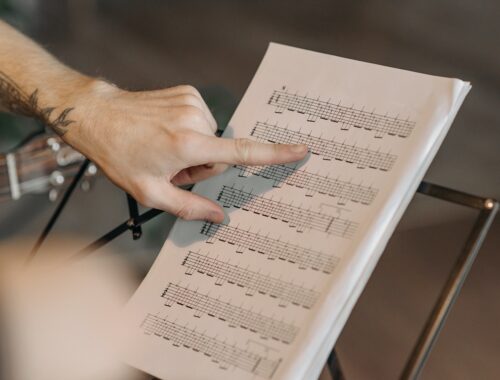
Practice Fingerpicking Techniques For Guitar
Fingerpicking is a popular technique used by guitarists to create complex and intricate patterns of notes. This technique allows guitarists to produce a wide range of sounds and textures, making it a valuable skill for players of all levels. If you are interested in improving your fingerpicking technique, then this article is for you. Here, we will explore some essential fingerpicking techniques and offer tips on how to practice them effectively.
Thumb and Fingers Placement
Before we delve into specific fingerpicking patterns, it is essential to discuss the proper placement of your thumb and fingers. When fingerpicking, your thumb is generally used to play the bass notes, while your fingers (index, middle, ring, and pinky) play the higher notes. To get the most out of your fingerpicking technique, you must position your thumb and fingers correctly.
First, place your thumb on the sixth string of your guitar (the thickest string) and your index, middle, ring, and pinky fingers on the first four strings (the thinnest strings). When playing fingerstyle, keep your thumb perpendicular to the guitar neck and rest it on the string below the one you are playing. This will help you achieve a consistent sound while playing.
Start Slowly
When practicing fingerpicking, it is essential to start slowly and gradually increase your speed as you become more comfortable with the pattern. Start by playing the pattern slowly with a metronome, gradually increasing the tempo as you improve. Playing slowly will help you focus on the pattern’s accuracy, hand positioning, and overall sound. Once you have the pattern down, you can gradually increase your speed and work on making the pattern smoother and more fluid.
Practice Fingerpicking Patterns
There are numerous fingerpicking patterns, and each one requires a unique approach. Here are some of the most popular fingerpicking patterns that you can practice to improve your technique.
1. Travis Picking: Travis Picking is a popular fingerpicking pattern that involves alternating between the bass notes and the higher notes. It is commonly used in folk, country, and rock music. To play this pattern, start by plucking the sixth string with your thumb, then pluck the first string with your index finger, the second string with your middle finger, and the third string with your ring finger. Repeat this pattern, alternating between the bass notes and higher notes.
2. Clawhammer: Clawhammer is another popular fingerpicking pattern used in folk music. It involves using your index finger to strike the string, followed by a flick of the thumb. To play this pattern, start by striking the fifth string with your index finger, then flick the string with your thumb. Repeat this pattern, alternating between the index finger and thumb.
3. PIMA: PIMA is a fingerpicking pattern that involves using your thumb, index, middle, and ring fingers. To play this pattern, start by plucking the sixth string with your thumb, then pluck the first string with your index finger, the second string with your middle finger, the third string with your ring finger, and the first string again with your index finger. Repeat this pattern, alternating between the thumb and the other fingers.
4. Arpeggio: Arpeggio is a fingerpicking pattern that involves playing the individual notes of a chord one at a time. To play this pattern, start by holding a chord with your left hand and plucking each string individually with your right hand. Begin with the root note, then play the third, fifth, and any other notes in the chord in any order you choose.
5. Flamenco: Flamenco is a traditional Spanish fingerpicking style characterized by its fast and intricate patterns. To play this style, start by using your thumb to play the bass notes, while your fingers (index, middle, and ring) play the higher notes. The pattern is often played in triplets, and the emphasis is on the downbeat. To practice this pattern, start by playing a basic triplet pattern with your thumb and fingers, focusing on the rhythm and the overall sound.
6. Classical: Classical fingerpicking is a style commonly used in classical and Spanish guitar music. It involves using your thumb to play the bass notes and your fingers (index, middle, ring, and pinky) to play the higher notes. To play this style, start by holding your hand in a relaxed position and plucking the strings with your fingers. Focus on producing a clear and consistent sound, and practice playing simple patterns before moving on to more complex ones.
7. Hybrid Picking: Hybrid picking is a technique that combines fingerpicking with the use of a pick. This style allows guitarists to play faster and more intricate patterns while still maintaining the rich and textured sound of fingerpicking. To play this style, hold your pick in your hand and use your thumb, index, and middle fingers to play the higher notes.
Practice with a Metronome
Using a metronome while practicing fingerpicking can help you improve your timing, accuracy, and speed. Start by setting the metronome to a slow tempo and practice playing the pattern in time with the beat. As you improve, gradually increase the tempo until you can play the pattern at a faster speed without sacrificing accuracy.
Experiment with Different Fingerpicking Styles
Fingerpicking is a versatile technique that can be used in many different styles of music. As you become more comfortable with the basics, experiment with different fingerpicking styles and patterns to find the ones that suit your musical tastes and goals. You can also try combining different styles to create unique and complex patterns.
Fingerpicking is a valuable skill for guitarists of all levels, and practicing these techniques can help you improve your accuracy, speed, and overall sound. Remember to start slowly, use a metronome, and focus on proper thumb and finger placement. With practice and dedication, you can become a skilled fingerstyle guitarist and add a new dimension to your playing.

Learn Songs You Enjoy
Record Yourself Playing
You May Also Like

Introduction to Guitar Music Theory: Unraveling the Language of Music
September 30, 2023
Barre Chords: Tips for Mastery
July 21, 2023